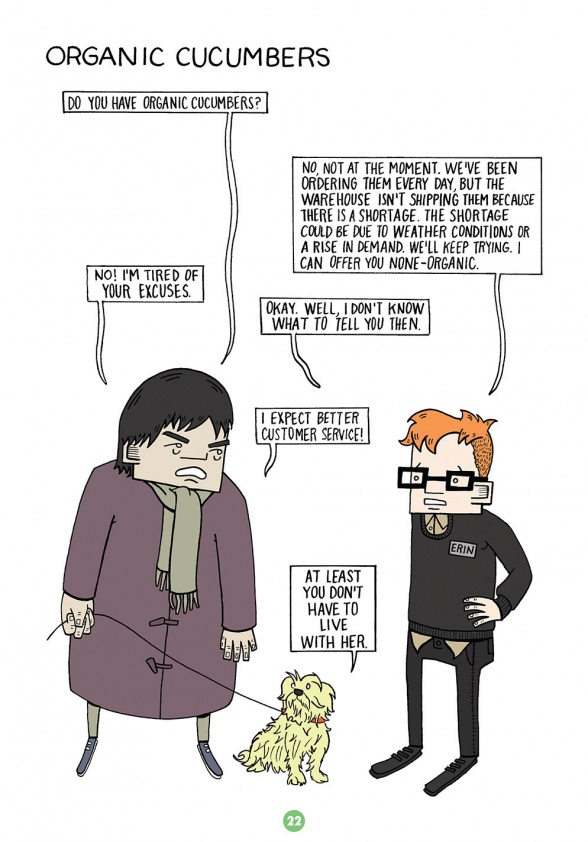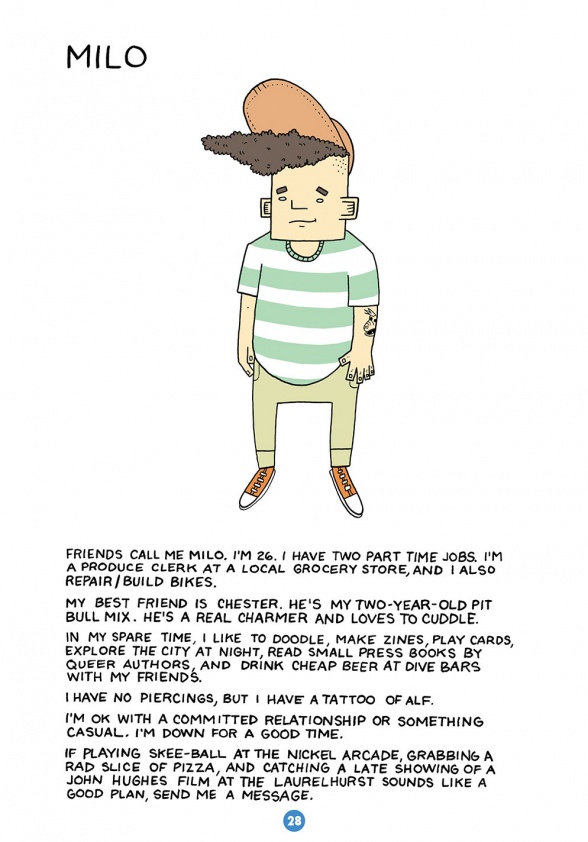From zines to comics, Erin Nations has done it all. His autobiographical comic published by IDW/Top Shelf Productions, “Gumballs,” is the first professionally published autobiographical comic by a trans cartoonist. Prior to “Gumballs” Erin has created content such as Meow: A Collection of Cat Portraits with Descriptions, and contributed to comics periodicals Vision Quest and Original Plumbing. With bright colors and a cartoonish, sculptural style, “Gumballs” uses humor and heart to share childhood memories (Erin is a triplet), quirky personal ads, and life as a transgender person. The fourth issue of “Gumballs” comes out in December, and I had the privilege to sit down and chat with this comics pioneer about zines, artistic influences, and representation of the trans experience in comics.

First, for those readers not familiar with “Gumballs,” tell us a little bit about the comic and its cast of characters.
Erin Nations: It’s a collection of short comics and some illustrations. Each issue features fictional personal ads, unpleasant customers I encounter at work, personal anecdotes of growing up as a triplet, autobiographical comics about my experience as a trans man, and a teenage loner named Tobias who longs for a boyfriend. I also incorporate visual diaries of my daily excursions.
Every superhero has an origin story. Tell us yours as both a comics fan and as a comics creator.
EN: They go hand in hand. I realized I wanted to make comics at the same time I started reading them. I was more interested in the visual components of comics. I was more interested in the linework and colors.
When I graduated High School, the film adaptation of Ghost World was released. I loved it. In college, my best friend asked me, “You know this is based on a comic book, right?” That changed everything for me. I finally discovered a comic book with a story I wanted to read. Ghost World introduced me to alternative comics and I became a fan.
I went to college for graphic design, but when I left, I realized I didn’t want to be a designer. I wanted to make comics.
What comics inspired you to create “Gumballs?” What inspirations — comics or otherwise — did you find to create the very unique cartoonish style we see throughout the books?
EN: I think Daniel Clowes Eightball and Adrian Tomine’s Optic Nerve were big inspirations for Gumballs. The style and content are different, but I liked the idea of creating a series of mini-comics.
My earliest influence was The Simpsons. I was obsessed with the show. I taught myself how to draw by copying those characters, so I’m sure it impacted my style. Beyond that, it’s hard to pinpoint other sources that have influenced my style because there’s an abundance of art that I’ve been exposed to. I’m sure it’s all influenced me in some ways that I wouldn’t even know how to pick apart.
The style I’ve adhered to for the past few years was a conscious decision. After college, I wanted a style that was unique and my own. I started to experiment with these square face characters. They used to be a lot more rigid and minimal. They’ve evolved in the last ten years.

You are a pioneer in the comics medium — the first trans cartoonist to publish an autobiographical comic. How has coming out and transitioning changed your view of the world, your writing, and/or your drawing style?
EN: It hasn’t changed my writing or drawing. I’m the same person I was before I transitioned. I draw the same and I write the same. Hormones changed my physical appearance and transitioning changed my state of mind (I’m happier and more confident now). If anything, I think time changes drawing and writing styles. Cis or trans, these things change as we grow as writers and artists.
Transitioning didn’t change my views of the world either because, while I knew I’d remain the same person, I anticipated a shift in how others would treat me. Society holds expectations of how we should behave and present ourselves based on our gender. Transitioning provided me with more insight. Now I know what it’s like to be treated as both male and female. For 33 years I felt societal pressures to act feminine and to take on female gender roles because I was read as a woman. For 2 years, I’ve felt societal pressures to act masculine and adopt stereotypical male roles because I’m read as a man.
Continued belowOne can imagine a certain level of creative license in any work, but how much of “Gumballs” is from your own direct, personal experience?
EN: Almost everything that appears in Gumballs comes from personal experience. The majority of the work is autobiographical with the exception of Tobias and the personal ads. At times, even Tobias is an exaggerated version of myself.

You started out in zine culture before you made the move to comics. For those readers at Multiversity who may not be familiar with zines, could you explain what a zine is and what made you change your medium of focus from zines to comics? Any plans on contributing or returning to zines in the future?
EN: A zine is short for “magazine”. Generally, they’re self-published, printed in small batches, and created with a DIY approach. When zines first emerged, they were constructed by arranging text and images on paper and then xeroxed and stapled. Today, people still use copy machines to create zines, but they’ve also evolved to incorporate other printing processes, materials, and binding techniques.
Zines are generally circulated at zine symposiums, online, or at bookstores that offer consignment to self-publishers.
The subject matter varies. Zines can be about different subcultures, politics, fan fiction, poetry, art, etc. There are no rules.
For me, there isn’t a huge difference between my comics and art zines. In fact, some of the material in Gumballs came from zines I made. However, my zines mostly feature sketchbook drawings, so I think the switch happened because I wanted to create stories. I wanted to make comic books.
I’ll definitely make zines in the future. In fact, I just made one last month that I sold at Short Run in Seattle. I stopped making zines because creating comics occupy too much of my time.
What can readers expect from the upcoming fourth issue (out in December)?
EN: It’ll contain more personal ads and customer interactions. A new character enters Tobias’ world. I explore my anxiety with using public restrooms as a transgender person. There’s a new visual diary regarding my artist residency at an offbeat lodge in Seaview, Washington. Also, my sisters and I become spooked by a ’80s board game.

As this interview is timed for Trans Awareness Week, how do you think comics creators and publishers are depicting the trans experience in the medium? What are things that the industry is doing right — and where is there room for improvement?
EN: It has taken decades, but in recent years, trans characters are finally emerging in comics and not just as supporting characters, or shapeshifters, or stereotypes (even though it still happens occasionally). How transgender characters are depicted is much more positive and accurate today in comparison to 15 years ago. Lumberjanes is a great example. It’s an incredibly queer-friendly comic, featuring female-led characters, one of which has a crush on her fellow female camper, and another who is a transgender woman of color. This all-ages comic is getting it right. It depicts positive queer/trans representation and it allows the readers to know that it’s cool to be yourself.
As far as improvement, more is still better. The most diverse comics I come across are online and unpublished. It’d be nice for those folks to be published and to see mainstream comics reflect the same diversity seen in small-press or unpublished comics. It’s not just the inclusion of transgender characters that I’d like to see in comics, but the inclusion of characters and creators of all gender identities, sexualities, races, and ethnicities.
Outside of the upcoming “Gumballs” book next summer, are there any other projects on your horizon?
EN: I have a new comic that will appear in the first issue of Full Bleed, which is a new quarterly magazine published by IDW. It’s scheduled to be released in December. I’m also excited to be featured in We’re Still Here, an all-trans comic anthology edited by Tara Avery and Jeanne Thornton at Stacked Deck Press.
Finally, Multiversity is a comics site for fans by fans. Give us a few comics recommendations of your own!
EN: Anything by Jillian Tamaki! I love her work. Especially This One Summer (written by Mariko Tamaki) and SuperMutant Magic Academy. I enjoy the work of Eleanor Davis. I just finished reading You & A Bike & A Road. Ben Passmore’s Your Black Friend. It’s a short story, but still profound. And check out the work of Lee Lai. She’s one of my favorites and such a brilliant artist. Earlier this year, she debuted her comic First Year at TCAF.



